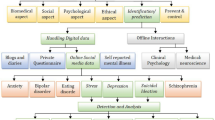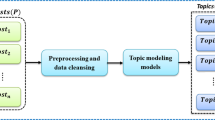Abstract
In general humans are said to be social animals. In the huge expanded internet, it's really difficult to detect and find out useful information about a medical illness. In anticipation of more definitive studies of a causal organization between stroke risk and social network, It would be suitable to help social individuals to detect the risk of stroke. In this work, a DRFS methodology is proposed to find out the various symptoms associated with the stroke disease and preventive measures of a stroke disease from the social media content. We have defined an architecture for clustering tweets based on the content using Spectral Clustering an iterative fashion. The class label detection is furnished with the use of highest TF-IDF value words. The resultant clusters obtained as the output of spectral clustering is prearranged as input to the Probability Neural Network (PNN) to get the suitable class labels and their probabilities. Find Frequent word set using support count measure from the group of clusters for identify the risk factors of stroke. We found that the anticipated approach is able to recognize new symptoms and causes that are not listed in the World Health Organization (WHO), Mayo Clinic and National Health Survey (NHS). It is marked that they get associated with precise outcomes portray real statistics. This type of experiments will empower health organization, doctors and Government segments to keep track of stroke diseases. Experimental results shows the causes preventive measures, high and low risk factors of stroke diseases.






Similar content being viewed by others
References
Yoon S, Elhadad N, Bakken S (2013) A practical approach for content mining of Tweets. Am J Prev Med 45(1):122–129
Hilliard C (2012) Social media for healthcare: a content analysis of M.D. Anderson’s Facebook presence and its contribution to cancer support systems
Lowe R, Bailey TC, Stephenson DB, Graham RJ, Coelho CAS, Sá Carvalho M, Barcellos C (2011) Spatio-temporal modelling of climate-sensitive disease risk: towards an early warning system for dengue in Brazil. Comput Geosci 37(3):371–381
Jain VK, Kumar S (2017) Effective surveillance and predictive mapping of mosquito-borne diseases using social media. J Comput Sci 25:406–415
Yoon J, Hagen L, Andrews J, Scharf R, Keller T, Chung E. On the use of multimedia in Twitter health communication: analysis of tweets regarding the Zika virus.
Roberts M, Callahan L, O’Leary C (2017) Social media: a path to health literacy. Inf Serv Use 37(2):177–187
Lampos V, Cristianini N (2010) Tracking the flu pandemic by monitoring the social web. In: 2nd IAPR workshop on cognitive information processing (CIP 2010), IEEE Press, pp 411–416
Chunara R, Andrews JR, Brownstein JS (2012) Social and news media enable estimation of epidemiological patterns early in the 2010 Haitian cholera outbreak. Am J Trop Med Hyg 86(1):39–45
Aramaki E, Maskawa S, Morita M (2011) Twitter catches the u: detecting influenza epidemics using Twitter. In: Proceedings of the conference on empirical methods in natural language processing, association for computational linguistics, pp 1568–1576
Jain VK, Kumar S (2015) An effective approach to track levels of influenza-A (H1N1) pandemic in India using twitter. Procedia Comput Sci 70(1):801–807
Keller M, Blench M, Tolentino H, Freifeld CC, Mandl KD, Mawudeku A et al (2009) Use of unstructured event-based reports for global infectious disease surveillance. Emerg Infect Dis 15(5):689
Acharya UR, Mookiah MR, Vinitha Sree S, Afonso D, Sanches J, Shafique S, Nicolaides A, Pedro LM, Fernandes E, Fernandes J, Suri JS (2013) Atherosclerotic plaque tissue characterization in 2D ultrasound longitudinal carotid scans for automated classification: a paradigm for stroke risk assessment. Med Biol Eng Comput 51(5):513–523. https://doi.org/10.1007/s11517-012-1019-0
Kim C, Zhu V, Obeid J, Lenert L (2019) Natural language processing and machine learning algorithm to identify brain MRI reports with acute ischemic stroke. PLoS ONE 14(2):e0212778
Oliveira E, Ciarelli PM, Goncalves C (2008) A comparison between a kNN based approach and a PNN algorithm for a multi-label classification problem
Wu D, Yang Q, Tian F, Zhang DX (2010) Fault diagnosis based on K-means clustering and PNN. In: Third international conference on intelligent networks and intelligent systems
Amini L, Azarpazhouh R, Farzadfar MT, Mousavi SA, Jazaieri F, Khorvash F, Norouzi R, Toghianfar N (2013) Prediction and control of stroke by data mining. Int J Prev Med 4(Suppl 2):S245
Twitter Developer Page. https://dev.twitter.com/docs/. Accessed 1 Jan 2015
Papadopoulos H, Kyriacou E, Nicolaides A (2016) Unbiased confidence measures for stroke risk estimation based on ultrasound carotid image analysis. Neural Comput Appl 28(6):1209–1223. https://doi.org/10.1007/s00521-016-2590-3
Zhang Y, Song W, Li S, Fu L, Li S (2018) Risk detection of stroke using a feature selection and classification method. IEEE Access 6:31899–31907. https://doi.org/10.1109/ACCESS.2018.2833442
Flueckiger P, Longstreth W, Herrington D, Yeboah J (2018) Revised framingham stroke risk score, nontraditional risk markers, and incident stroke in a multiethnic cohort. Stroke 49(2):363–369. https://doi.org/10.1161/STROKEAHA.117.018928
Yang X, Li S, Zhao X, Liu L, Jiang Y, Li Z, Wang Y, Wang Y (2017) Atrial fibrillation is not uncommon among patients with ischemic stroke and transient ischemic stroke in China. BMC Neurol 17(1):207. https://doi.org/10.1186/s12883-017-0987-y
Chang CS, Su SL, Kuo CL, Huang CS, Tseng WM, Lin S, Liu CS (2018) Cyclophilin A: a predictive biomarker of carotid stenosis in cerebral ischemic stroke. Curr Neurovasc Res 15(2):111–119. https://doi.org/10.2174/1567202615666180516120959
Bao Y, Quan C, Wang L, Ren F (2014) The role of pre-processing in Twitter sentiment analysis. In: ICIC, Taiyuan, China, pp 615–624
Zhang X, Attia J, D'Este C, Yu X, Wu X (2005) A risk score predicted coronary heart disease and stroke in a Chinese cohort. J Clin Epidemiol 58(9):951–958. https://doi.org/10.1016/j.jclinepi.2005.01.013
Cho S, Ku J, Cho YK, Kim IY, Kang YJ, Jang DP, Kim SI (2014) Development of virtual reality proprioceptive rehabilitation system for stroke patients. Comput Methods Prog Biomed 113(1):258–265. https://doi.org/10.1016/j.cmpb.2013.09.006
Haijiao L, Xiaohua K (2015) Study of automated essay scoring based on small dataset extraction algorithm. In: 2015 4th international conference on computer science and network technology (ICCSNT)
Saba L, Banchhor SK, Londhe N, Araki T, Laird J, Gupta A, Nicolaides A, Suri JS (2017) Web-based accurate measurements of carotid lumen diameter and stenosis severity: an ultrasound-based clinical tool for stroke risk assessment during multicenter clinical trials. Comput Biol Med 91:306–317. https://doi.org/10.1016/j.compbiomed.2017.10.022
Park E, Chang HJ, Nam HS (2017) Use of machine learning classifiers and sensor data to detect neurological deficit in stroke patients. J Med Internet Res 19(4):e120. https://doi.org/10.2196/jmir.7092
Niwattanakul S, Singthongchai J, Naenudorn E, Wanapu S (2013) Using of Jaccard coefficient for keyword similarity. In: Proceedings of the international multi conference of engineers and computer scientists (IMECS), vol I, Hong Kong, Mar 13–15, 2013
Di Iorio B, Di Micco L, Torraca S, Sirico M, Guastaferro P, Chiuchiolo L, Nigro F, De Blasio A, Romano P, Pota A, Rubino R, Morrone L, Lopez T, Casino FG (2013) Variability of blood pressure in dialysis patients: a new marker of cardiovascular risk. J Nephrol 26(1):173–182. https://doi.org/10.5301/jn.5000108
Ab Malik N, Mohamad Yatim S, Lam OL, Jin L, McGrath CP (2017) Effectiveness of a web-based health education program to promote oral hygiene care among stroke survivors: randomized controlled trial. J Med Internet Res 19(3):e87. https://doi.org/10.2196/jmir.7024
von Luxburg U (2007) A tutorial on spectral clustering. Springer, Berlin
Vimal S, Kalaivani L, Kaliappan M, Suresh A, Gao X-Z, Varatharajan R (2018) Development of secured data transmission using machine learning based discrete time partial observed markov model and energy optimization in Cognitive radio networks. Neural Comput Appl. https://doi.org/10.1007/s00521-018-3788-3
Shi J, Malik J (2000) Normalized cuts and image segmentation. IEEE Transn Pattern Anal Mach Intell 22(8):888
Newman MEJ (2006) Modularity and community structure in networks. Proc Natl Acad Sci USA 103(23):8577–8582. https://doi.org/10.1073/pnas.060160210312
Vimal S, Kalaivani L, Kaliappan M (2017) Collaborative approach on mitigating spectrum sensing data hijack attack and dynamic spectrum allocation based on CASG modeling in wireless cognitive radio networks. Clust Comput. https://doi.org/10.1007/s10586-017-1092-0
Mariappan E, Kaliappan M, Vimal S (2016) Energy efficient routing protocol using Grover’s searching algorithm for MANET. Asian J Inf Technol 15:4986–4994
Ilango SS, Vimal S, Kaliappan M et al (2018) Optimization using Artificial Bee Colony based clustering approach for big data. Clust Comput. https://doi.org/10.1007/s10586-017-1571-3
Kannan N, Sivasubramanian S, Kaliappan M, Vimal S, Suresh A (2018) Predictive big data analytic on demonetization data using support vector machine. Clust Comput. https://doi.org/10.1007/s10586-018-2384-8
Specht DF (1990) Probabilistic neural networks. Lockheed Missiles & Space Company, Inc.
Geetha R, Sivasubramanian S, Kaliappan M, Vimal S, Annamalai S (2019) Cervical cancer identification with synthetic minority oversampling technique and PCA analysis using random forest classifier. J Med Syst 43(9):286
Ibrahiem M, El Emary M, Ramakrishnan S (2008) On the application of various probabilistic neural networks in solving different pattern classification problems
O'Brien MK, Shawen N, Mummidisetty CK, Kaur S, Bo X, Poellabauer C, Kording K, Jayaraman A (2017) Activity recognition for persons with stroke using mobile phone technology: toward improved performance in a home setting. J Med Internet Res 19(5):e184. https://doi.org/10.2196/jmir.7385
Breccia M, Molica M, Zacheo I, Serrao A, Alimena G (2015) Application of systematic coronary risk evaluation chart to identify chronic myeloid leukemia patients at risk of cardiovascular diseases during nilotinib treatment. Ann Hematol 94(3):393–397. https://doi.org/10.1007/s00277-014-2231-9
Annamalai S, Udendhran R, Vimal S (2019) Cloud-based predictive maintenance and machine monitoring for intelligent manufacturing for automobile industry. In: Novel practices and trends in grid and cloud computing. IGI Global, pp 74–89
Annamalai S, Udendhran R, Vimal S (2019) An intelligent grid network based on cloud computing infrastructures. In: Novel practices and trends in grid and cloud computing. IGI Global, pp 59–73
Tunstall-Pedoe H (2011) Cardiovascular risk and risk scores: ASSIGN, Framingham, QRISK and others: how to choose. Heart 97(6):442–444
Hu T, Yao L, Reynolds K, Whelton PK, Niu TH, Li SX, He J, Bazzano L (2015) The effects of a low-carbohydrate diet vs a low-fat diet on novel cardiovascular risk factors: a randomized controlled trial. Nutrients 7(9):7978–7994. https://doi.org/10.3390/nu7095377
Pencina M, D'Agostino RB, Larson MG, Massaro JM, Vasan RS (2009) Predicting the 30-year risk of cardiovascular disease: the framingham heart study. Circulation 119(24):3078–3084. https://doi.org/10.1161/CIRCULATIONAHA.108.816694
Author information
Authors and Affiliations
Contributions
SP is responsible for system implementation and algorithm selection. KRM is responsible for data collection and analysis. SV is responsible for first draft manuscript writing and algorithm verification. MSK is responsible for Experimental verification and system design manipulation. NC is responsible for data processing. AKL is responsible for revising the manuscript and algorithm development.
Corresponding author
Ethics declarations
Conflict of interest
The authors declare that they do not have any conflict of interests.
Research Involving Human and Animal Rights
This research does not involve any human or animal participation.
Additional information
Publisher's Note
Springer Nature remains neutral with regard to jurisdictional claims in published maps and institutional affiliations.
Rights and permissions
About this article
Cite this article
Pradeepa, S., Manjula, K.R., Vimal, S. et al. DRFS: Detecting Risk Factor of Stroke Disease from Social Media Using Machine Learning Techniques. Neural Process Lett 55, 3843–3861 (2023). https://doi.org/10.1007/s11063-020-10279-8
Published:
Issue Date:
DOI: https://doi.org/10.1007/s11063-020-10279-8




